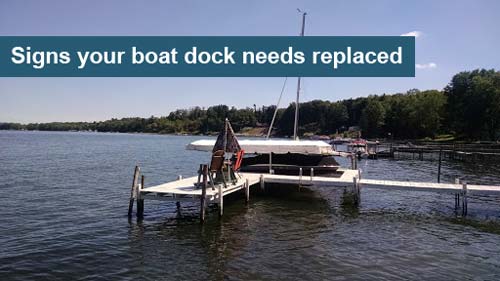Is your dock starting to feel a little worn out? Are your boat dock materials a collection of new and old wood used to replace rot? Have years of waves and currents warped your once-straight dock into a crooked and uneven walkway?
Sometimes a boat dock deteriorates to a point beyond simple repair. Docks that hit this stage are dangerous and unreliable—one bad step could end in injury or even death.
In some instances, dock repair is an option and your dock's useability can be prolonged. But knowing the difference between having a dock in need of repair or replacement can be difficult—and costly. Below are five telltale signs that your dock is beyond repair and needs to be replaced.

Boat dock materials come in many different forms; wood, metal and composite are just a few. Depending on the material, currents and waves can warp or bend your structure under the pressure, sometimes even leading it to crack and break. Running boats into your structure while docking your watercraft is also a major culprit of cracked and broken supports.
If cracks are minor and are limited to a small area of your dock, you could replace individual boards and beams, depending on your dock’s material. However, if major load-bearing areas have substantial breakage, it is most likely in your best interest to replace the whole thing to ensure structural integrity. If a boat collision caused the breakage, consider installing posts outside the perimeter of your dock to not only tie up boats, but also to add a barrier.
It is not uncommon for wooden docks to experience a little rot over time. Sometimes fungus from the water can lead to dry rot, causing your wooden boat dock materials to decay and crumble. If you notice this issue in sporadic areas, you could simply remove the rotted board and replace it with new, treated lumber. However, if the rot is not contained to small areas, the dock should be replaced.
Some docks are permanently installed with the help of pillars and underwater foundational support systems. These docks provide the convenience of easy surface repair and stability in most water conditions, but it gets very tricky if they take on damage or erosion. Special equipment may be needed to even assess the damage, let alone fix it. Foundational deterioration is very dangerous, and any cracking requires further investigation of the boat dock material to ensure it is not a sign of a larger issue.
Any dock made with metal has a chance of rusting when exposed to water. Small rust spots can be repaired or may simply require replacement of individual parts. However, if your supports seem to be overtaken by rust, it may be more worthwhile to replace the entire system or consider floating dock materials.
Sometimes, the need to replace a dock is not even related to damage or wear of the dock itself. Unless you own a floating dock, supports that hold up the dock must be driven into the ground at least 4 feet deep to ensure stability. Different water conditions can cause the water's floor to erode over time, making this 4-foot minimum impossible. If you cannot plant the supports with the help of a vacuum pump, consider changing out your dock for a floating structure.
To avoid having to replace your dock, make sure that you are continually checking and maintaining your dock throughout the year. Ensure all rotted wood is replaced with treated lumber, your dock is sealed at least once a year and that all metal components are lubricated to prevent rust.
Owning a boat can be one of the greatest hobbies and lifestyle changes you can get. Whether your boat is an 18-foot power boat, a party-going pontoon or a zippy PWC, nothing beats life on the water. If your dock deterioration is interfering with time on your boat, make replacement easy with a Jet Dock floating dock and lift system! Our floating dock materials are durable, modular pieces that are designed to last. Create and order your custom floating dock today!
By answering a few quick questions we will be able to tell you which dock or boat lift is the perfect fit for you.
Start Now! ▶